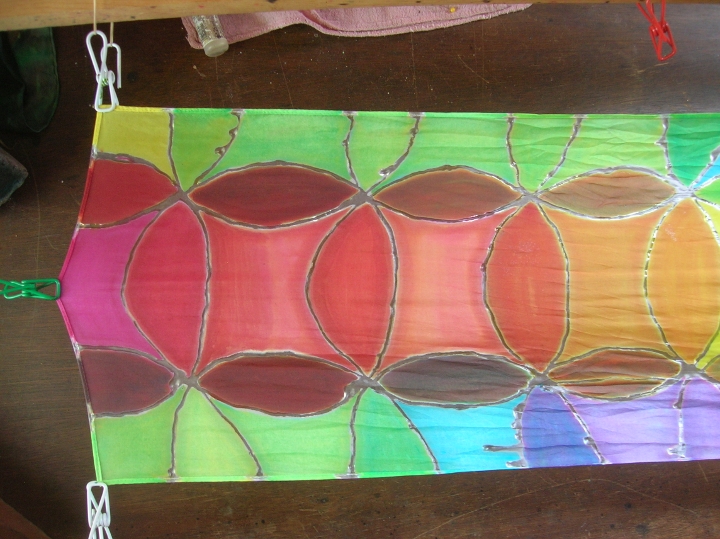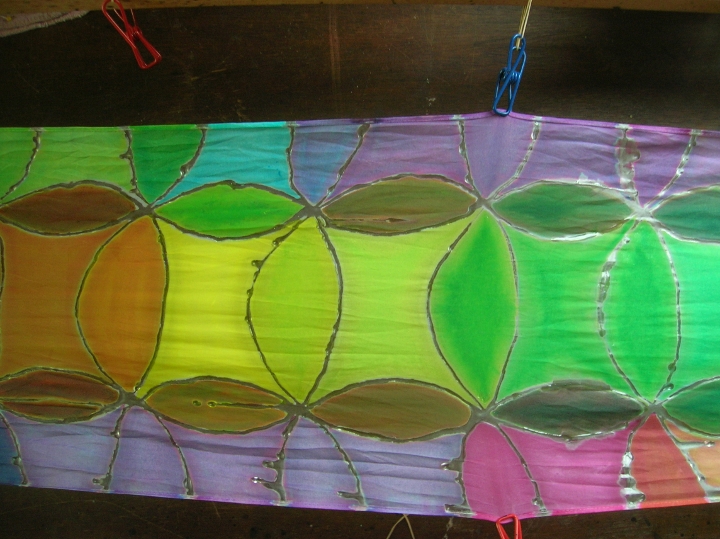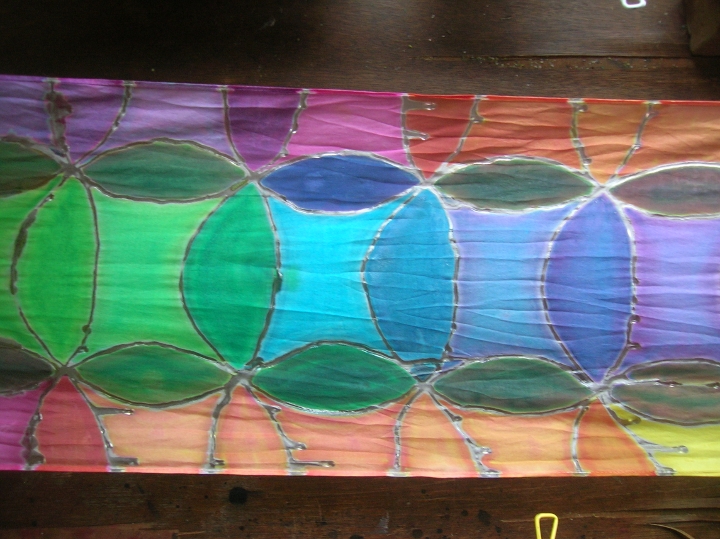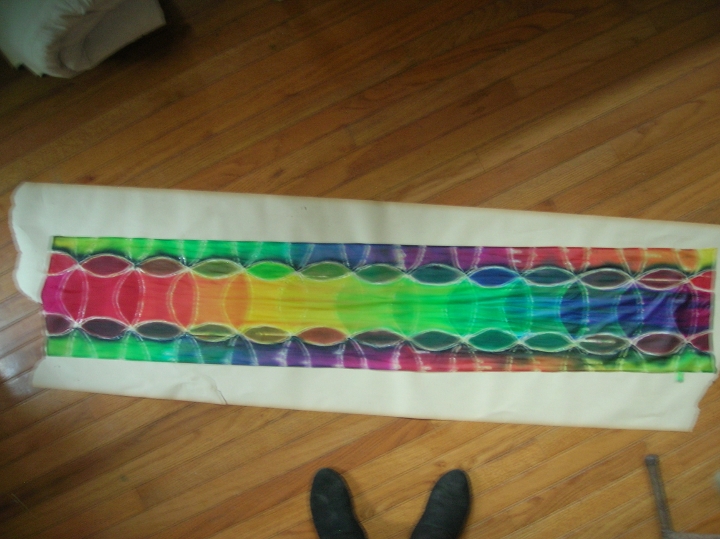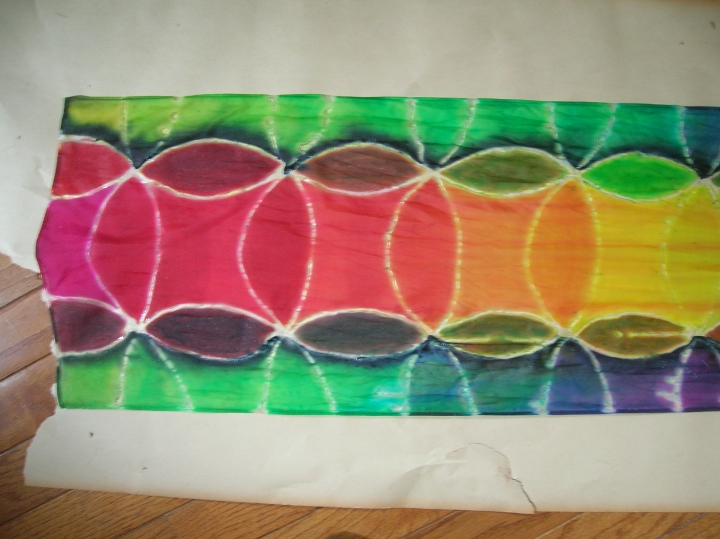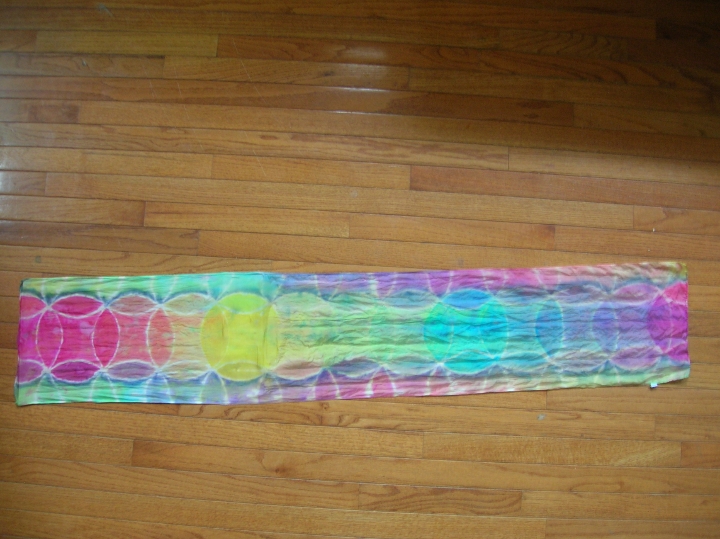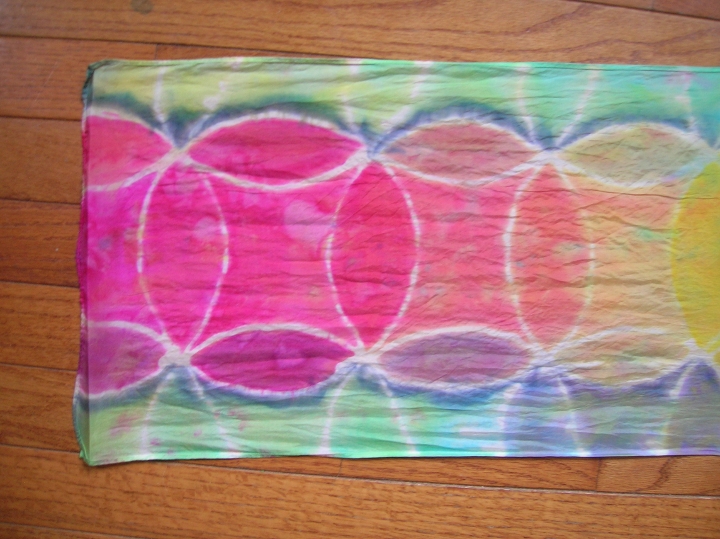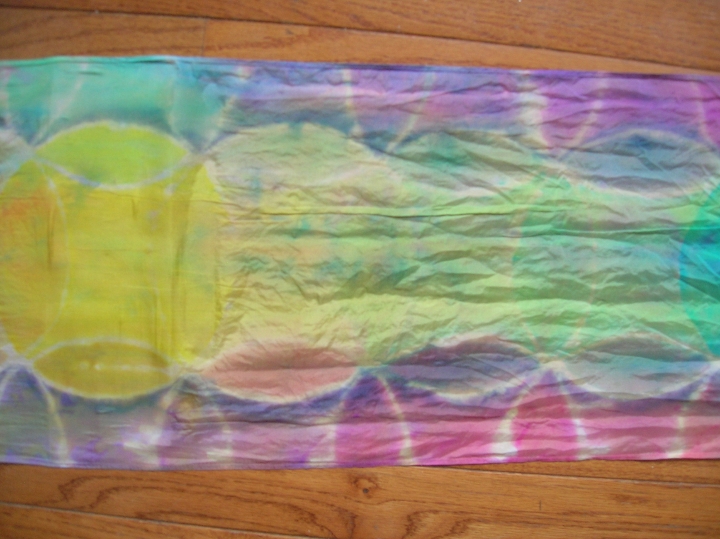One of the things Jim and I work on a lot is painted silk. He designs and I execute. Dragons, elves, trolls, puffins, landscapes, snow scenes with northern lights. I’ve been painting on silk since 2000, and taught it for several years, but as much as I have picked up in twenty years is nothing next to real experts (Paula Burch and many others). I don’t so much study as play with my materials, but familiarity makes you a more competent artist.
I’ve always used dyes on silk. Fiber reactive dyes. They’re persnickety, but every medium has a learning curve. I was looking thru the vast range of products at Golden paints, at the GAC formulations. They’re mediums of different characteristics that do different things for various different things you might want to do with acrylic paint. And there’s one that you can use on fabric, that’s supposed to not leave much of a hand. {A hand is the term for what a piece of fabric feels like with paint on it (like those embossed sweatshirts. like those screen printed t-shirts). Any stiffness caused by dried paint gives the fabric a hand, and it’s not desirable on something as fine as a light piece of silk. It gets crushed a few times, and whatever’s painted on it will start to crack.)
I once had a used silk sari that had been painted to enhance its natural beauty. And it was a vintage sari, so from maybe a few decades back. While it was a nice painted pattern, the paint was stiff and pokey and the sari didn’t want to pleat. It was easy to flake off whole flower petals. And the silk underneath the paint was dried and fragile, and cracked off in leaf-shaped chunks. So fabric paint is not archival, while dyes are (as far as that goes). But what do I know? I use my silk scarves until they’re full of holes, blowing right past archival and into the compost pile.
Fabric paints have improved over the years since that sari was painted. And they’ve developed these acrylic mediums with special powers. I read a bit. Golden has two kinds of acrylic paint that will work on fabric. And two different mediums that go with fabric paint. So I called them up and asked my usual dumb questions, and then went to some art supply store online (not trying to be coy, I just don’t remember which of the several I ended up buying from this time) and bought the mediums and a process-color spread of both the fluid acrylics and the high flow acrylics. There’s a difference. And I’m going to explore it. But not in this post. Because shit happened and now I have to wait to play with the acrylics.
I got GAC900, for fabric painting. It’s heat set (and I wonder if that includes steaming (note – no. steam setting is not recommended for gac900. use an iron)). It’s used with high flow acrylics for tie-dye effects, and with fluid acrylics for brushing on. It’s supposed to leave a very soft hand. (I’m just reading this, here; I have no idea how it works yet) I also got a wetting aid, which reduces surface tension and helps the paint flow. I guess that’s like ox gall for watercolors, but for acrylics. I don’t know. Anyway, I had to wait forever for these products to show up, and in the meantime I ordered all new fiber reactive dyes, because my big tubs of dyes were several years old, and I don’t think you’re supposed to keep them all that long…)
So the whole process I was going to document with this post would be way too long anyway, covering as it does two different mediums. So I’m just going to leave all this talk about acrylics here, and continue with the dyeing, simply because the acrylics took forever to arrive in the mail.

I had known the ancient dye in my tubs were going wonky when I tested my dyes and resists in preparation for painting a silk tie, something I need to do for one of my nephews who’s all grown up now.

So when I started making test scarves for the painted tie, in July, I decided I wanted to use black resist. When I mixed black dye with my favorite sodium alginate resist, the thick gooey resist fell apart, got all watery. So, no. Can’t do that. Wonder why. So I bought some black water-based resist online, and it was horrible, quite unstable, washed right out. That’s the resist in the square scarf above. Useless. I left a bad review. I ordered new sodium alginate and tried again. It made a perfectly good resist by itself, but something about the black dye just destroyed its thick viscousness. Shrug. Okay, then, I’ll use clear resist.

I did a bunch of tests for the tie, on 60×10″ silk habotai scarves. I was trying to see what exact blue/black background would both take salt well (salt makes a cool texture), and would look good against the most crimson red I could get with a mixture of magenta and lemon yellow (both primaries).
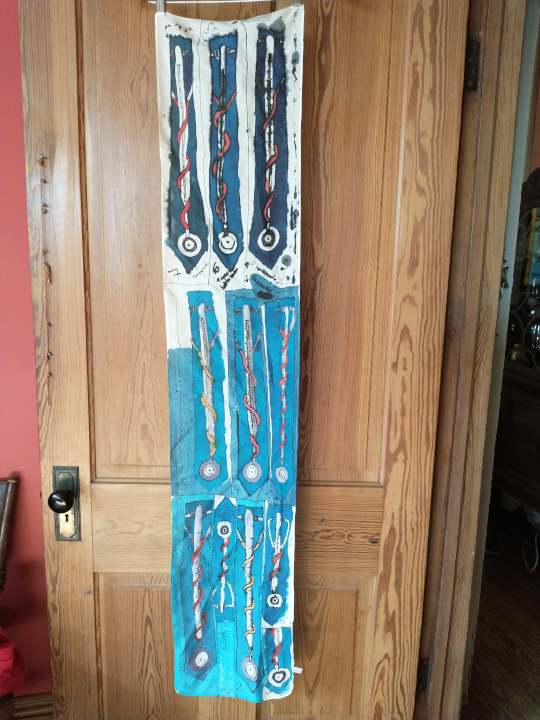
I kept careful (if cryptic) notes, because it’s for a commission, and I don’t feel as comfortable being all inspired and slapdash if I’m trying to produce high quality work. And arrived at a need for further tests. hah. The black dye was way too strong, and wouldn’t spread at all on the scarf – good for drawing precise lines that won’t move. I had to dilute it by 10x or more to get it to flow, and had to use 50:1 mixtures of clear water to black dye in order to achieve a silvery metalic kind of color. So I needed to toss the dyes I’d made up and start again, with even better record-keeping.

Then I steamed the test pieces. You have to steam silk to get dyes to set. I have a handmade steamer, from a stock pot with a steamer insert, and a six foot length of 12″ exhaust duct, all taped together. Because a professional steamer costs $700, that’s why. People who come to the house wonder if it’s a bong.

It was very disappointing to discover that a very great percentage of the blue washed out, as well as lots of the yellow. for that matter, the black was mostly down to gray after washing out the steamed scarves, even tho the black was so strong when I painted it on. So, more testing. I threw out my big tubs of dye.

I went to Dharma Trading and ordered 2oz jars of the four colors I use (there are close to a hundred colors available), the same colors you use for commercial printing, called process colors. Primaries of a sort. Not blue, red, yellow and black, but cyan (turquoise) and magenta, yellow and black. You can make all the colors with them, but cyan is a greenish blue, and magenta is a bluish pink. There’s a learning curve.
I also ordered a dozen 11×11 habotai handkerchiefs to use to test the new dyes, and the new paints. Next post.

Sodium alginate needed mixing. After seeing how it fell apart when I added black dye, I was afraid it might be old, so I ordered new alginate, and it made up resist beautifully. Way stronger than that nasty commercial resist. I just had to move on from the idea of using a black resis for this design.
It still took another few weeks to get the acrylics all delivered and ready to go, so in the meantime I took five handkerchiefs and did five different tests. First off, I got one handkerchief wet with vinegar and let it dry (I read somewhere that adding acid to regular fiber reactive dyes turns them into acid dyes, which is what you should use for silk and wool (because bases ruin protein fibers like animal wool and insect cocoons). (don’t take my word for it, that’s why I was doing the test). I did two of the same design – the eye nebula – with one on a vinegar soaked scarf and one not. It was good to splash dye around and not count drops and record amounts.




But then I got the notebook out and mixed up all the various range of mixed blues and mixed reds. I tried not to repeat any of the ratios over the range of 3 pieces (just in case there was one sample that was exactly right). I studied my notes to see what I’d already made a sample of, and tried to work in a very wide range of mixed colors (like 50:1 to 1:50). A nice red subject, and nice blue background with salt stars. the colors of the tie. A nice clear blue that’s not too dazzlingly turquoise, and a redder-than red that wasn’t orange. plus how to make a shape look like metal using diluted black.

I hate grids. They’re useful for organizing things, it’s true. There’s nothing better than a grid for scaling up a drawing to fit on a wall. But I don’t like plaid. i don’t like normal color-chart marks. I usually design something in a circular format when i have to do color ranges. A spiral, concentric circles, odd sinuous forms. Just not all squares, please.
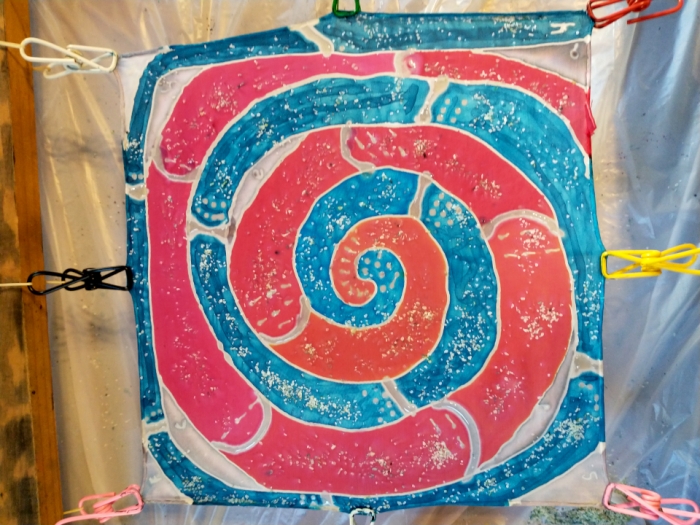
These were all designs of various combinations of red and yellow from 10:1 to 1:1 (I really didn’t want to end up with orange). Blue and black went from 50:1 down to 1:1. Even a little black makes any color darker.

That’s something that’s different between dyeing and regular painting with pigments and a binder. I learned to paint avoiding the use of black many, many years ago (after accepting the gift of a pint of Guinness from a patron while painting the bar in which I was sitting, and putting black in everywhere, which totally messed up the delicate, nuanced portrait I had been doing so well on). So anything but black. Want a good dark? Try alizarin crimson (this was many years ago) and phthalo blue, with a touch of phthalo green for balance. Or ultramarine with burnt umber. Black deadens, robs the light from colors around it. I have trouble using black to this day. But in dyeing, you need black to make any kind of shade whatever. You can mix red, blue and yellow all you want, but it’s never going to be more than brown. A lovely glorious golden brown at that. But add just a touch of black, and it becomes a rich, dark color. So just a touch of black to blue makes all sorts of post-sunset blues, glowing blues. And here’s a good one – black and yellow make green. Yellow and blue make this nasty acid color, but black and yellow make a great olive green. The rules are different for dye.

After letting them air dry for a couple of days, i took three sheets of newsprint and laid the scarves out not touching each other (because they would bleed).

Then rolled the newsprint up and got out some craft paper to wrap the bundle in.

It’s important to seal the bundle so that it doesn’t fall apart when it gets wet. Wet paper has no strength. I’ve had dye bundles fall into the water inside my steamer. Not a good look. So I double them, and tape them strongly. Then I have to run a hole thru the top of the bundle and thread a hanging wire thru.
Then hang the wire at the top of the stovepipe and make sure the bundle doesn’t touch the sides of the pipe. Then a bunch of towels to keep the steam blocked, and a weight on top of the towels to hole them down. Easy peasy. Looks fun, doesn’t it. Looks really stable. What could go wrong with a six foot stovepipe topheavy over a stock pot full of boiling water?

Let simmer for hours and hours. Two, they say. But I’ve had things not even damp after two. I always overdo it. I’m not sure if you can steam something too long. I’m sure it’s possible.

after being washed out and run thru a hot water cycle. You can see the bleeding marking up the paper. The new dyes held up very well, so that means I can proceed with the tie, because I know the colors are reliable. As far as that goes. Some of each color washed out. I can’t get an adequate blue for the background of the tie. I’ll need to do more testing.

There’s no use at all to compare how well the dyes stood up after steaming, or whether there was a color shift. These are things i need to look at for my notes, but because digital cameras and non-calibrated screens, there’s very little actual information I can get out of these photos.

All the same, these tests are quite useful. My notes give me the formulas for each experiment, and I can hunt and peck for the exact right color. Dyeing, like cooking, isn’t an exact science.

The blues are being tested not just for shade (cyan+black), but also what concentrations do well with the salt technique. I’m not getting very strong results from any of these samples.

It’s sucky how bad the colors show in these photos. To the eye there is a lot of variation of color in the reds and blues. On screen, it just looks like the same color with shadows in places. (But then, that’s how you make a shadow using dyes. Just add black, and it gets depth and form.

here’s how to tell if you’ve steamed your silk long enough. It bleeds all over the newsprint. In this case, the scarves washed mostly clear after a little time under cold running water, before i tossed them into the hot water of the washing machine. Hot water and commercial fabric detergent – synthropol or equivalent. followed by a vinegar rinse, because silk and wool need an acid environment to be strong fibers.
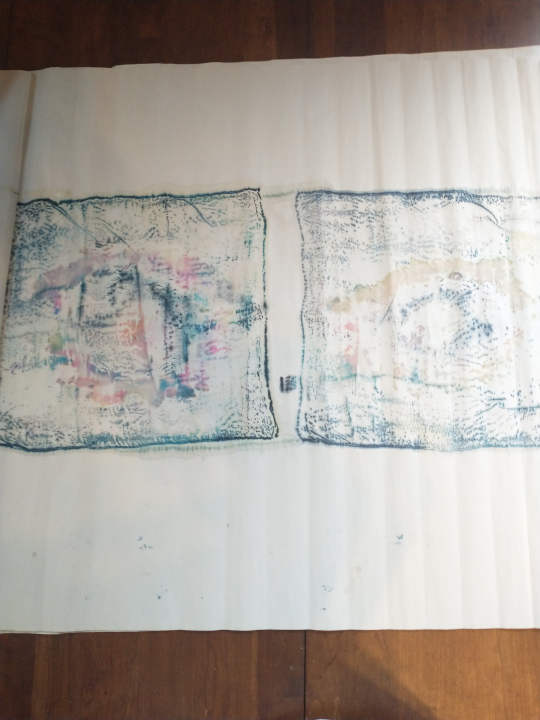
This is only the first part of this saga, because now I get to test a bunch of fabric paint, to see if modern improvements in materials and methods have made them a thing I might want to become involved with. Dyeing is a craft in itself, and in many ways very different from painting. But then again, it’s painting in another medium, and that makes all the difference. Plus, there’s a learning curve.
Stay tuned for more Experiments in Fabric Painting

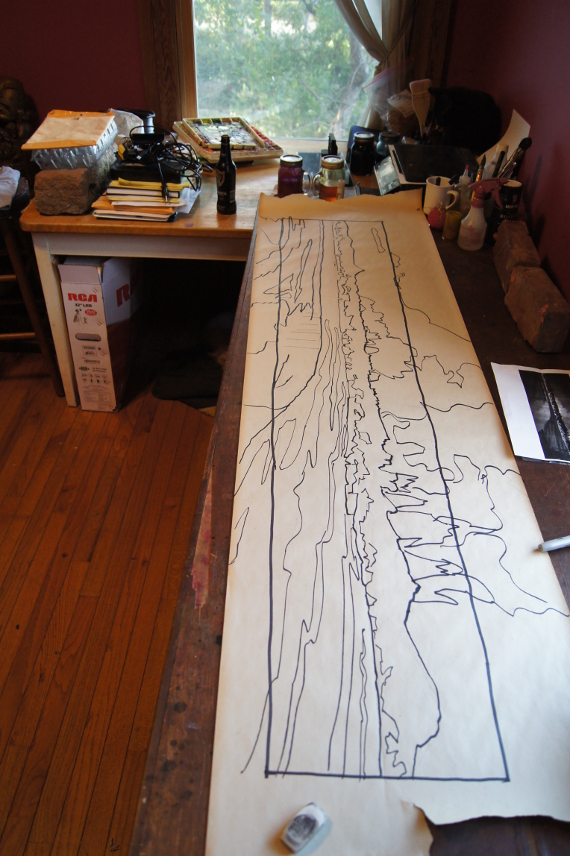









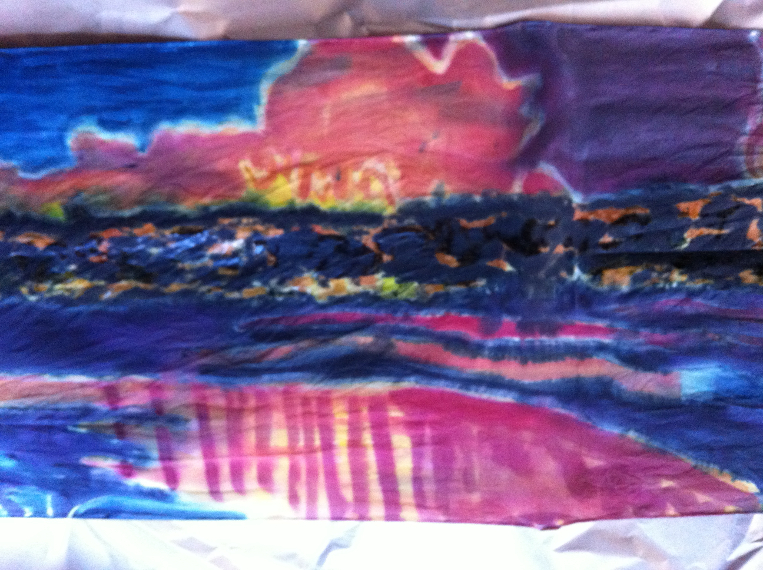













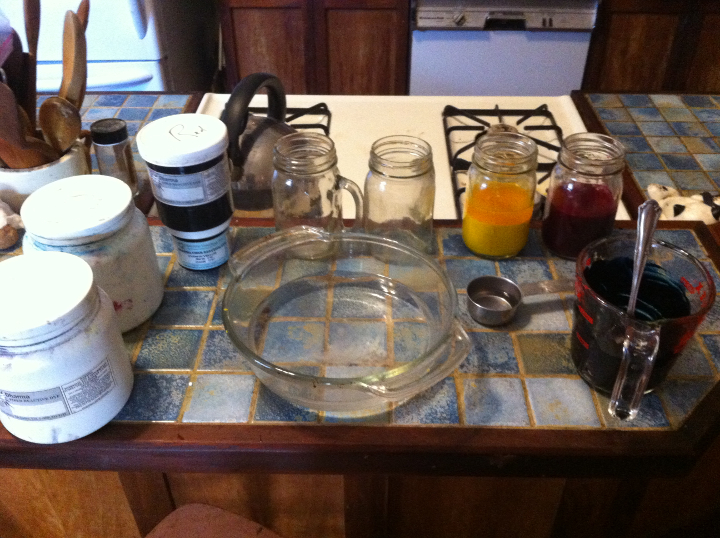

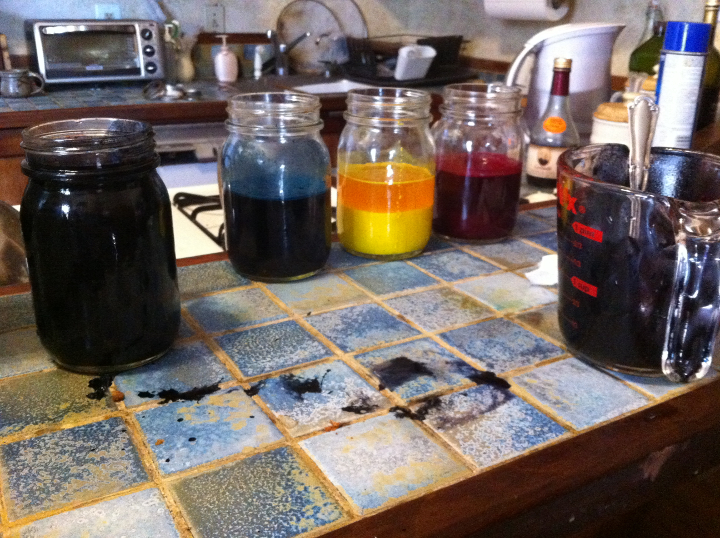




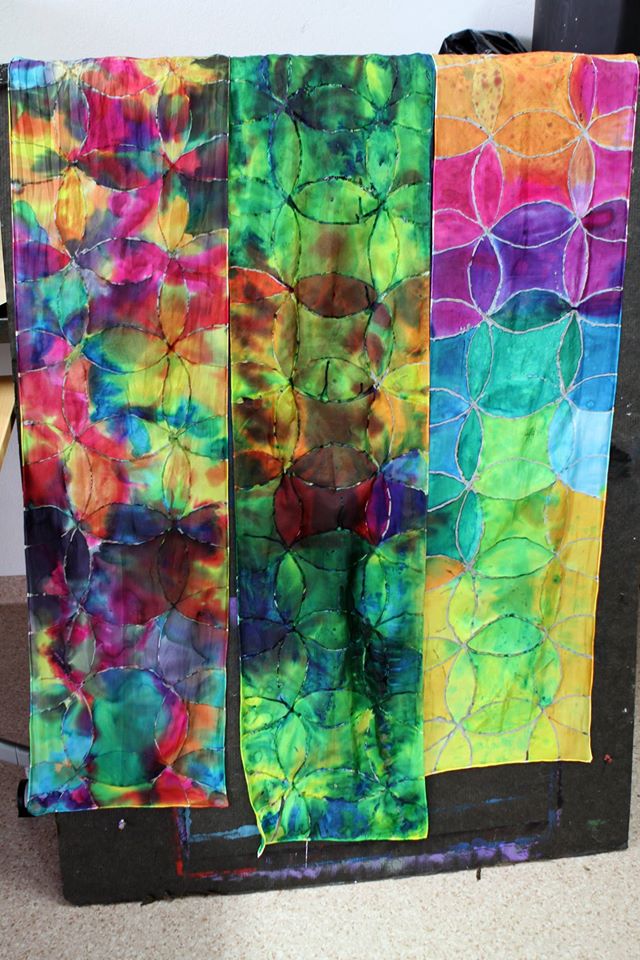
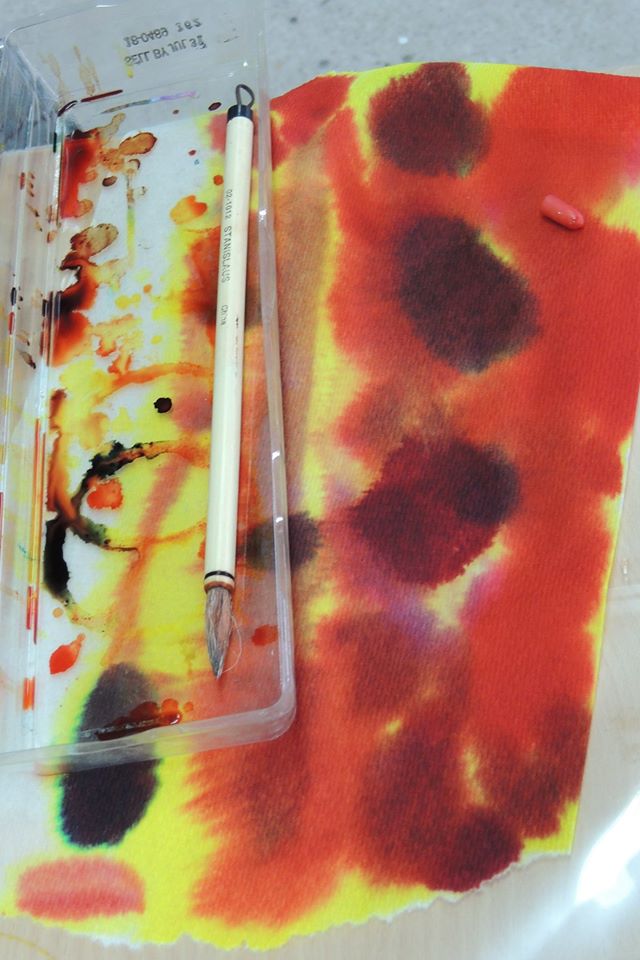

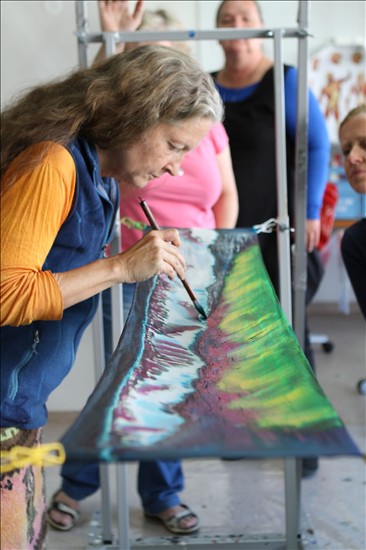





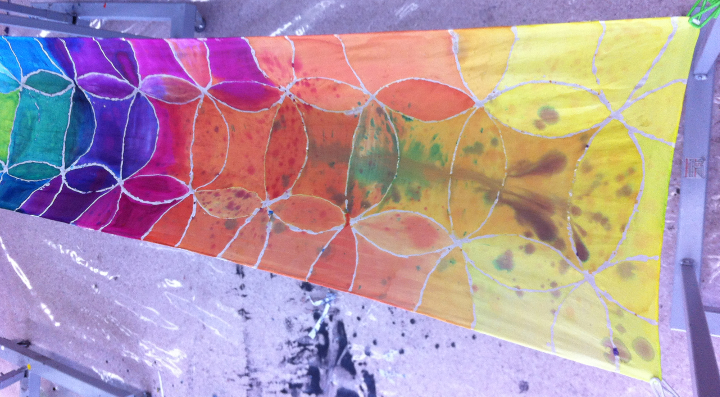








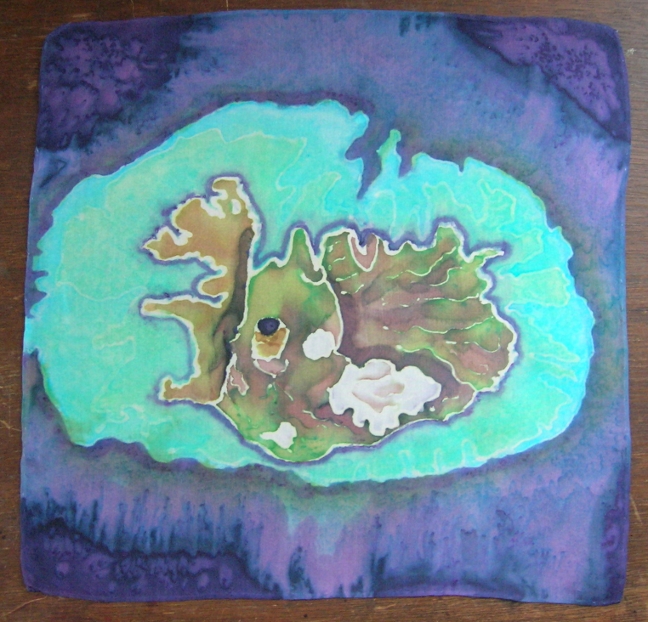



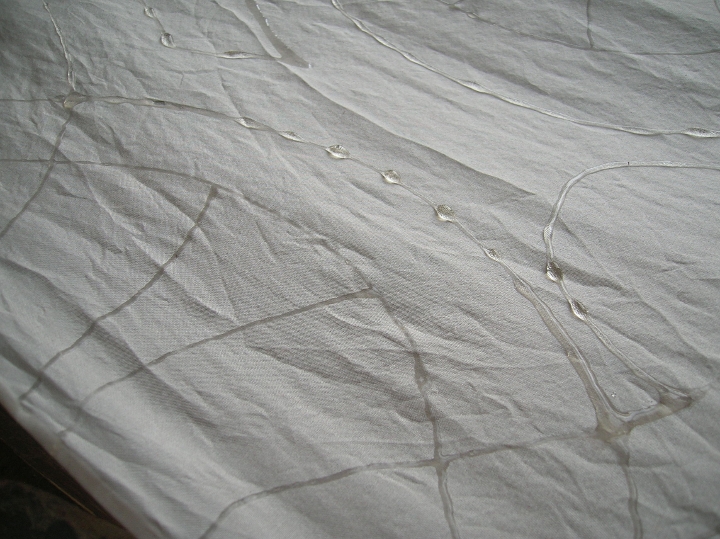
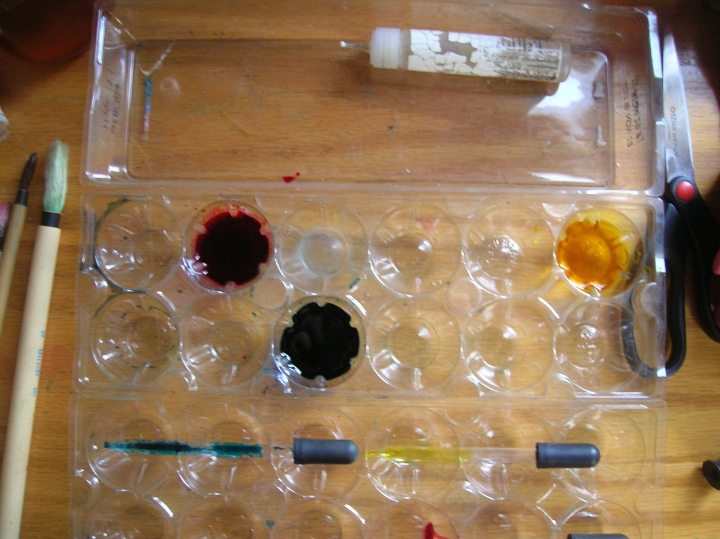
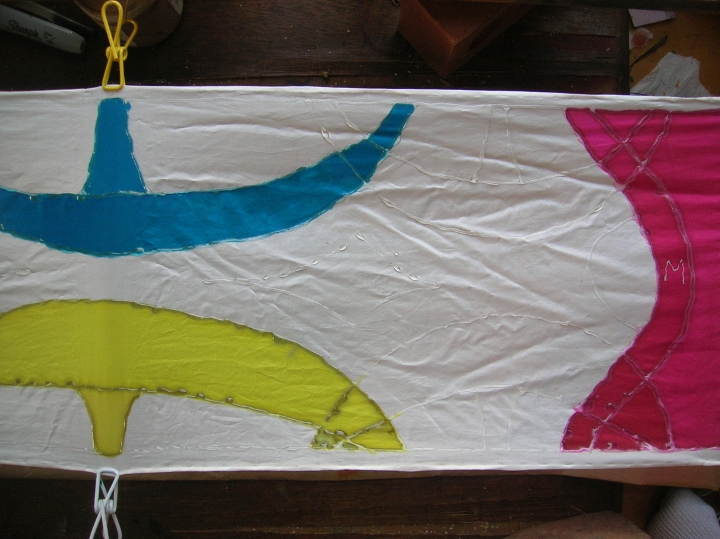
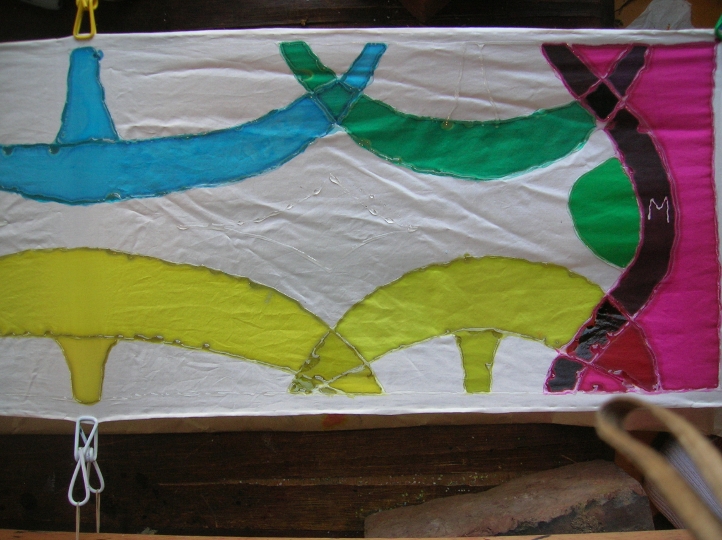
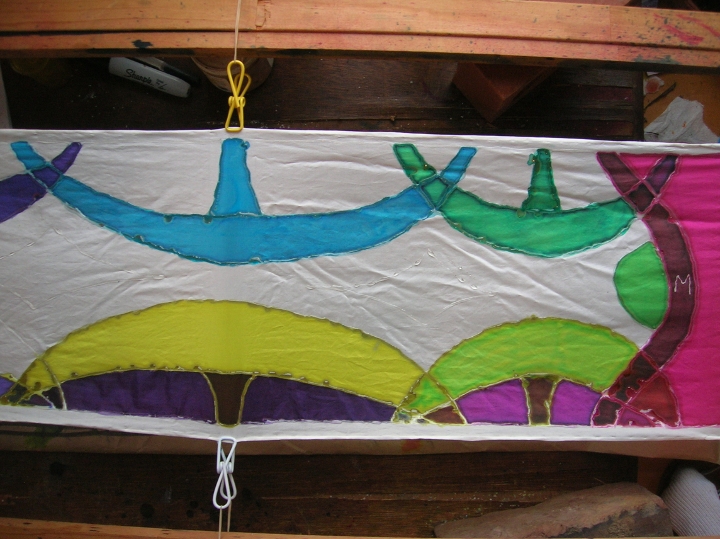
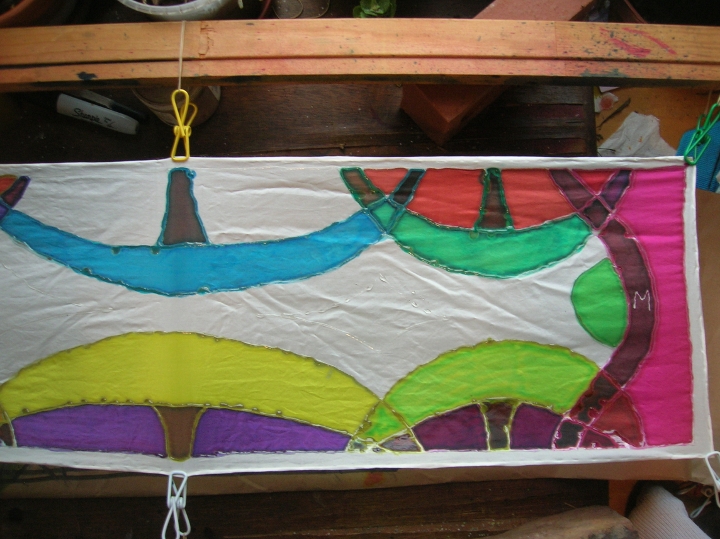
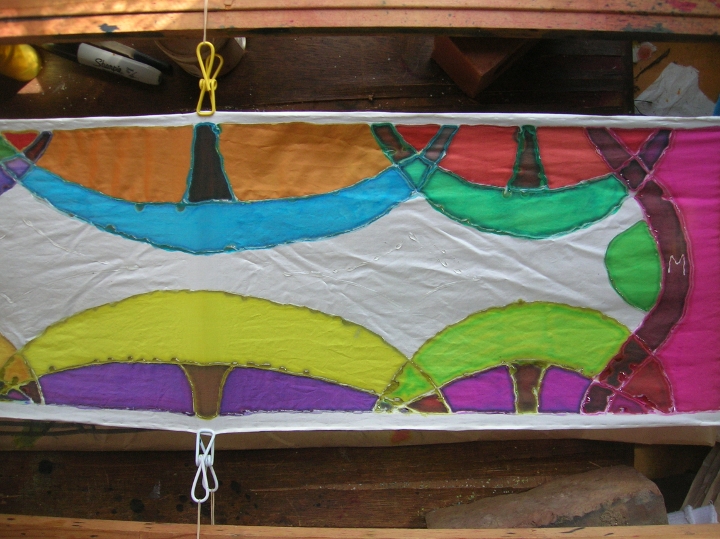
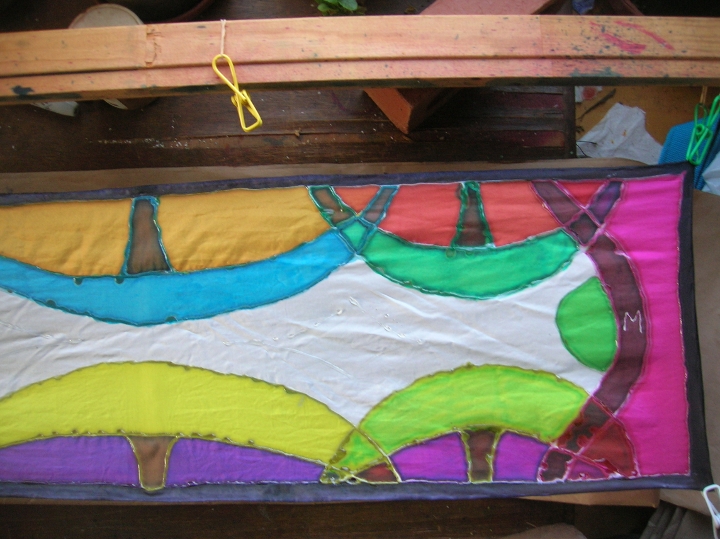
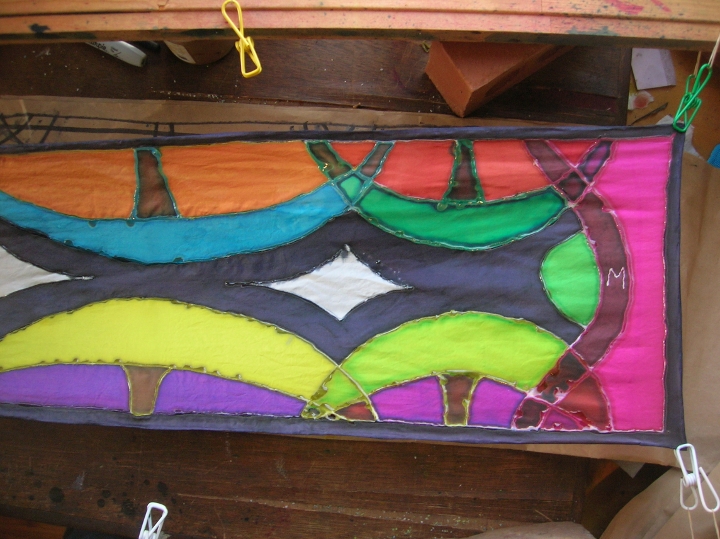
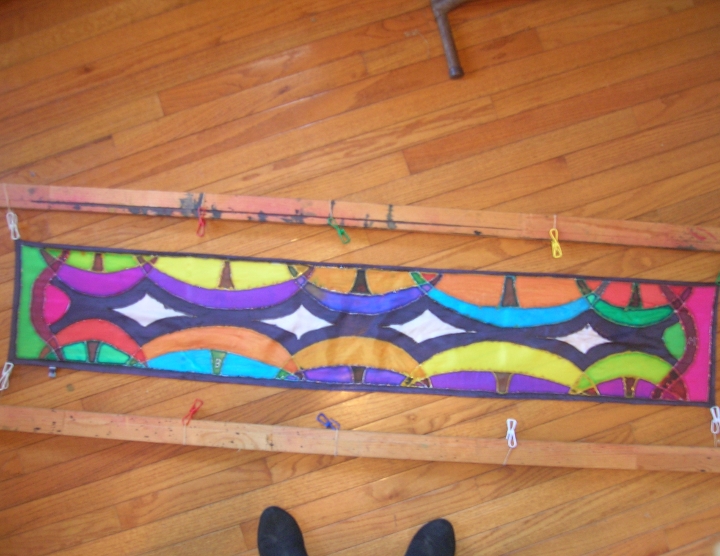
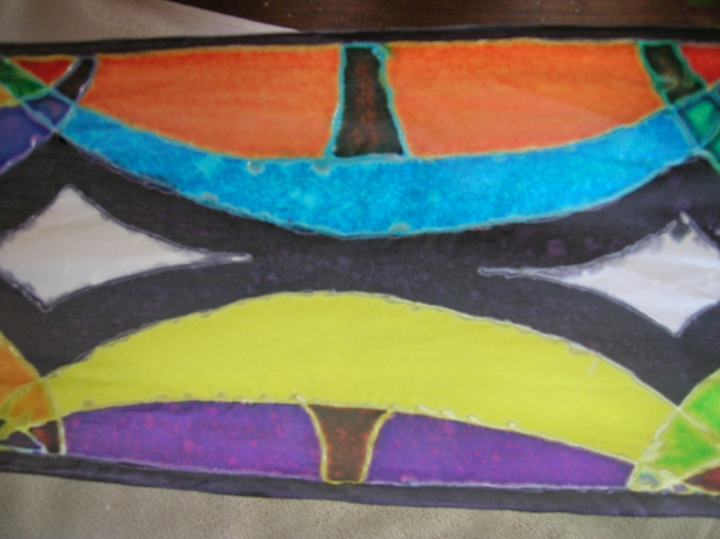

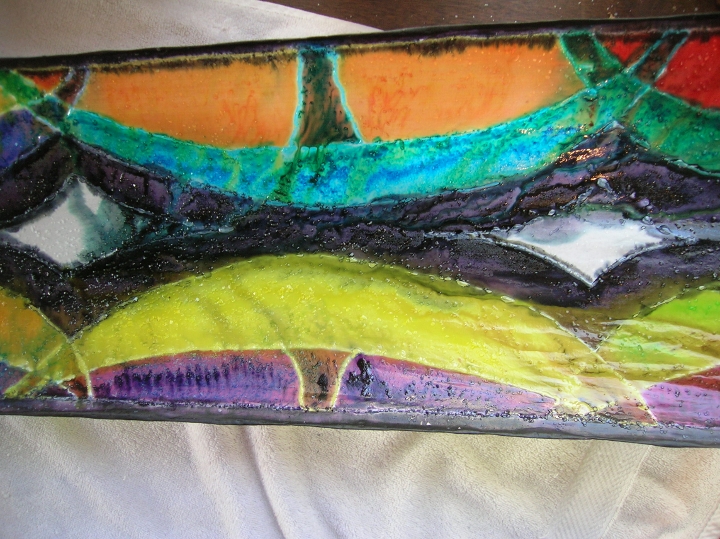


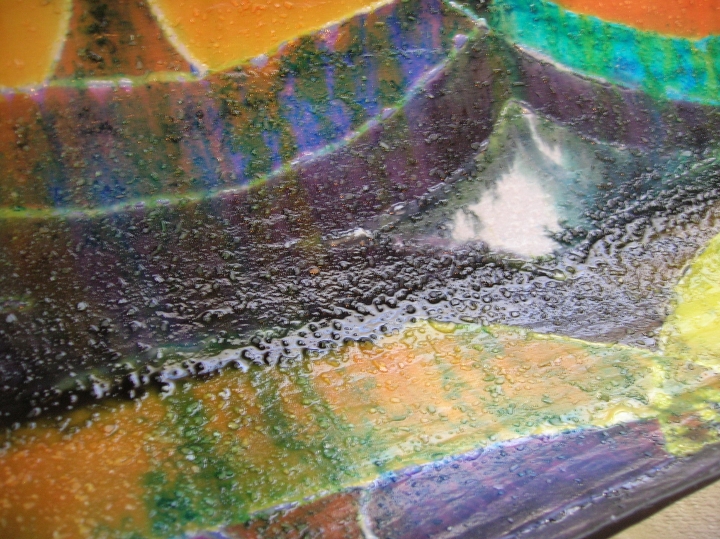
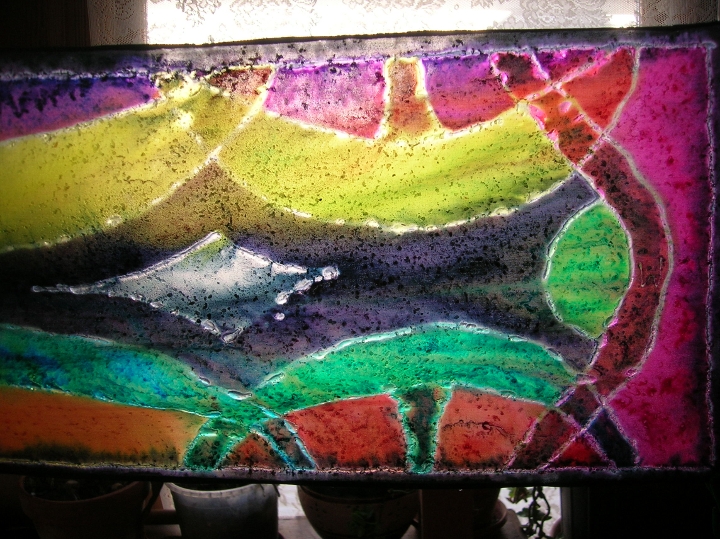

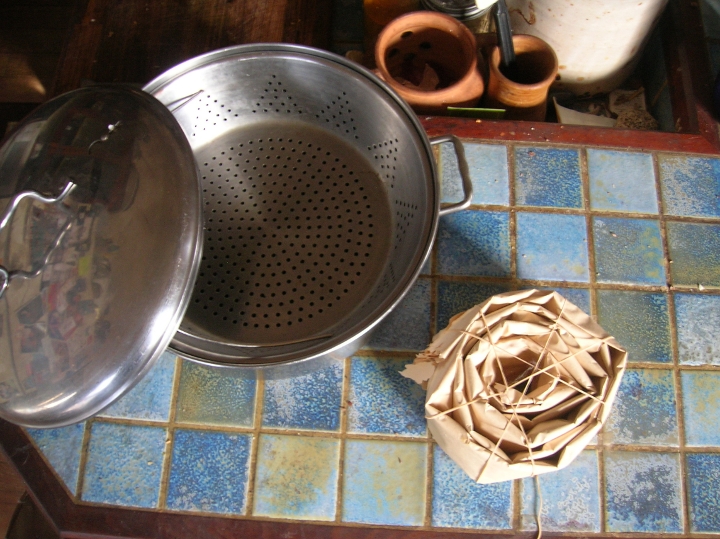

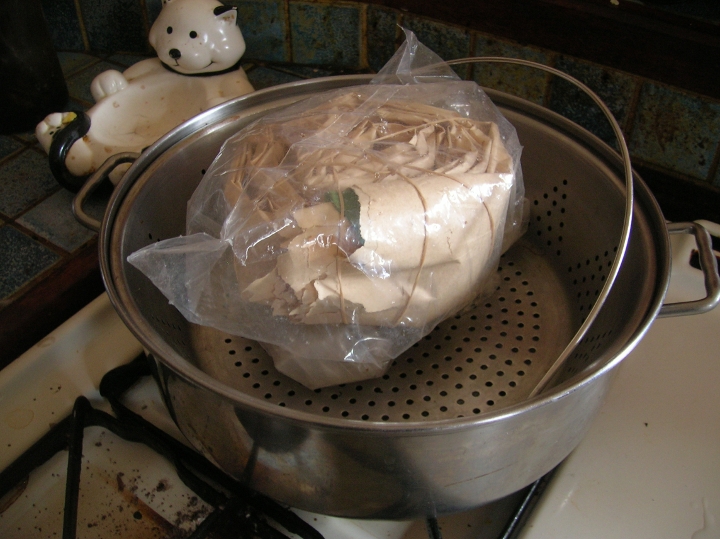
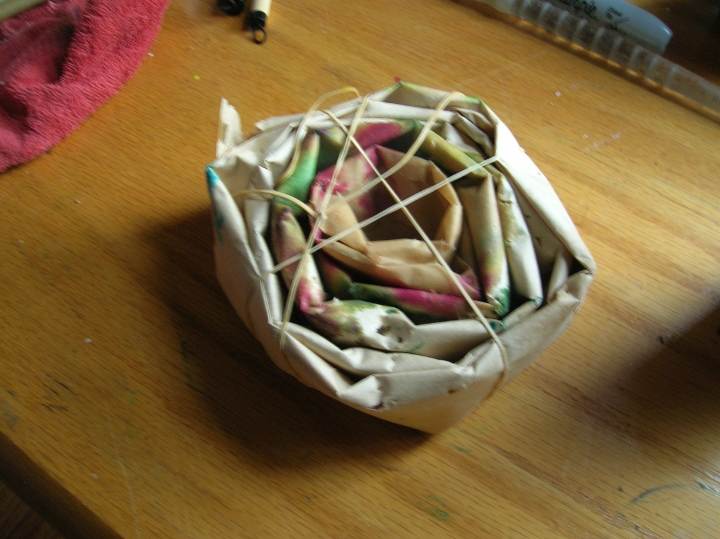
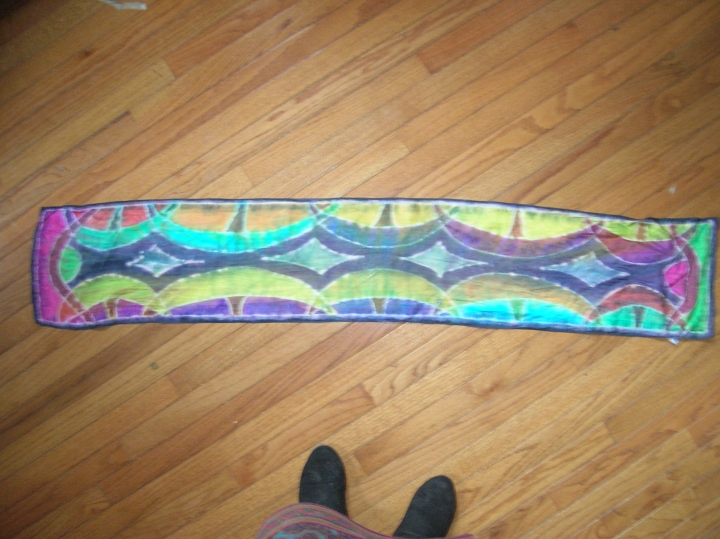

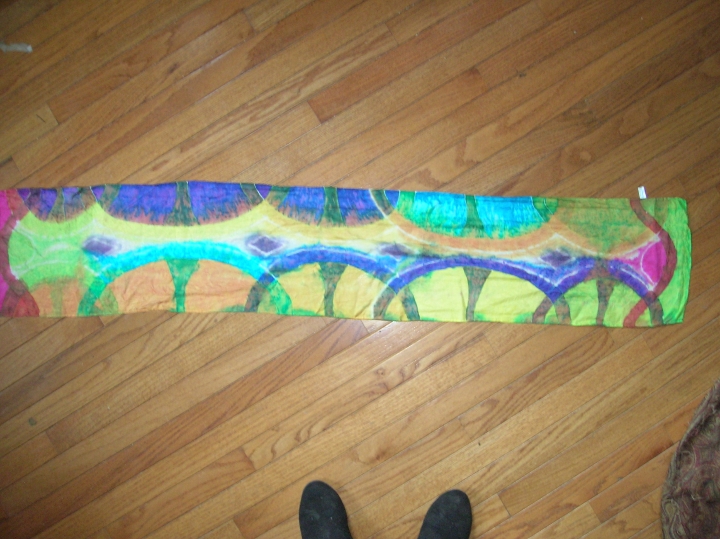

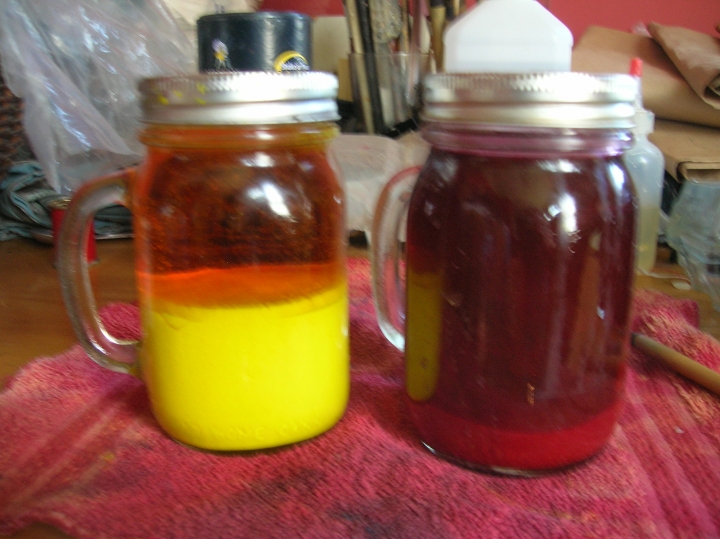

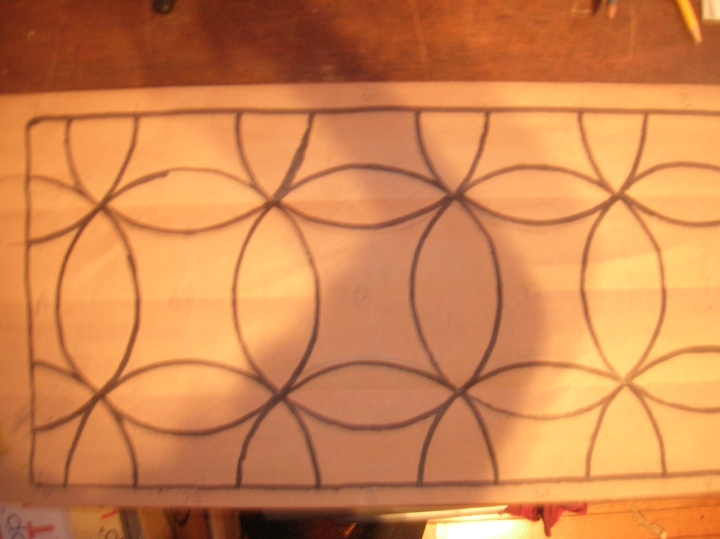
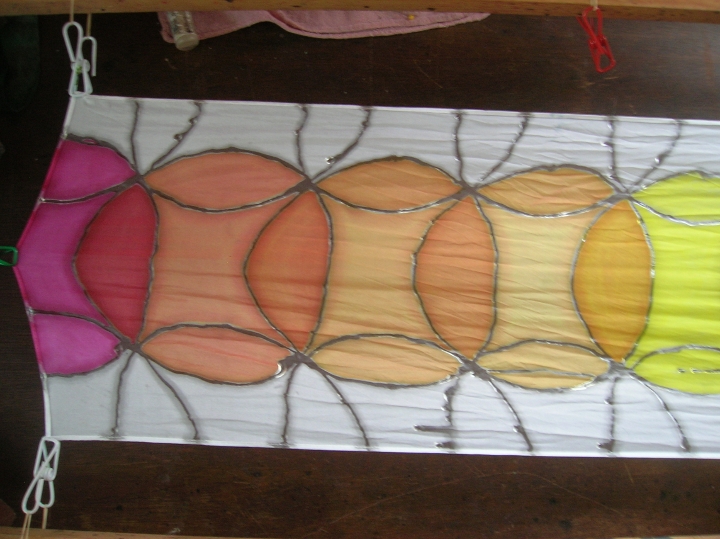
 .and so on down the line. here’s the range from yellow orange to blue
.and so on down the line. here’s the range from yellow orange to blue

